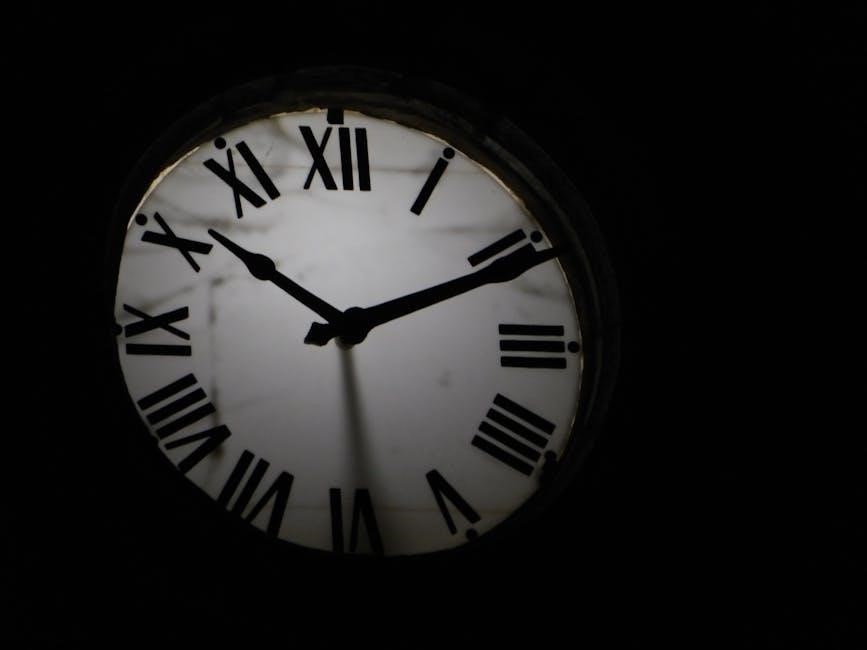The late-night salivary cortisol test measures cortisol levels in saliva‚ helping diagnose conditions like Cushing’s syndrome. It’s a non-invasive method to assess hormonal balance and adrenal function.
Overview of the Test
The late-night salivary cortisol test is a diagnostic tool used to measure cortisol levels in saliva‚ typically collected between 11 p.m. and midnight. This timing is chosen because cortisol levels naturally follow a circadian rhythm‚ peaking in the morning and reaching their lowest point at night. The test is particularly useful for screening and monitoring conditions like Cushing’s syndrome‚ where cortisol levels remain elevated even at night. Saliva sampling is non-invasive and allows patients to collect the specimen at home‚ making it a convenient alternative to blood or urine tests. Accurate results depend on proper sample collection and adherence to pre-test instructions. This method helps healthcare providers assess adrenal function and hormonal balance effectively.
Importance of Cortisol Measurement
Cortisol is a vital hormone produced by the adrenal glands‚ playing a central role in stress response‚ metabolism‚ and maintaining blood sugar levels. Measuring cortisol levels is crucial for diagnosing hormonal imbalances‚ particularly Cushing’s syndrome‚ where cortisol levels remain elevated. High cortisol levels can lead to symptoms like weight gain‚ hypertension‚ and mood changes‚ while abnormally low levels may indicate adrenal insufficiency‚ causing fatigue and low blood pressure. The late-night salivary cortisol test captures cortisol levels when they should naturally be at their lowest‚ providing insights into adrenal function and hormonal balance. Accurate measurement aids in early detection and monitoring‚ ensuring timely interventions and personalized treatment plans.

Preparation for the Test
Proper preparation ensures accurate results. Avoid food‚ drink‚ and brushing teeth for 30 minutes before collection. Refrain from steroids and relax for 1 hour beforehand.
Relaxation and Rest
Relaxation is crucial before the late-night salivary cortisol test to ensure accurate results. Stress and physical activity can elevate cortisol levels‚ potentially leading to misleading outcomes. Patients should avoid strenuous activities and stressful situations for at least 1 hour prior to sample collection. It is recommended to engage in calming activities‚ such as reading or meditating‚ to maintain a relaxed state. A restful environment helps stabilize cortisol levels‚ reflecting the body’s natural hormonal state. Proper rest ensures the test accurately measures cortisol without external influences‚ providing reliable data for diagnosis and further evaluation. Adhering to these guidelines is essential for obtaining precise results.
Dietary Restrictions
Adhering to dietary restrictions is essential to ensure accurate results in the late-night salivary cortisol test. Patients should avoid eating or drinking for at least 30 minutes before collecting the saliva sample. This includes refraining from brushing teeth‚ using mouthwash‚ or chewing gum‚ as these activities may contaminate the sample or alter cortisol levels. Additionally‚ consuming black liquorice for two weeks prior to the test should be avoided‚ as it can interfere with cortisol measurements. It is also important to avoid any substances that may influence cortisol levels‚ such as steroid creams or inhalers‚ for at least 24 hours before the test. Following these dietary guidelines helps ensure the saliva sample reflects the body’s natural cortisol levels‚ providing reliable results for accurate diagnosis and assessment.

Oral Hygiene Instructions
Proper oral hygiene is crucial before collecting a saliva sample for the late-night cortisol test. Avoid brushing your teeth‚ flossing‚ or using mouthwash for at least 30 minutes prior to sample collection‚ as these activities may alter cortisol levels or contaminate the sample. Additionally‚ refrain from chewing gum or eating any food 30 minutes before the test. Patients should also avoid smoking for at least two hours before collecting the sample. It is important to ensure the mouth is free of any substances that could interfere with the test results. Following these oral hygiene guidelines helps maintain the integrity of the saliva sample‚ ensuring accurate and reliable cortisol measurements for proper diagnosis and assessment.

Collection of Saliva Sample
Saliva collection involves using a swab between 11 pm and midnight. Avoid touching the swab with fingers. Relax beforehand to ensure accurate cortisol measurement.
Timing of Sample Collection
The saliva sample must be collected between 11:00 p.m. and midnight‚ as cortisol levels are typically lowest during this time. Accurate timing ensures reliable test results. Multiple tests over several nights may be required for confirmation. Avoid collecting the sample earlier or later than specified‚ as this could lead to inaccurate measurements. Proper timing aligns with the body’s natural circadian rhythm‚ ensuring the test reflects true cortisol levels. Adhering to the recommended timeframe is crucial for diagnosing conditions like Cushing’s syndrome. If the timing is not followed‚ the test may need to be repeated to obtain valid results.

Handling the Collection Device
Proper handling of the collection device is essential for accurate test results. Begin by washing your hands thoroughly with soap and water. Open the Salivette tube and place the cylindrical cotton pad in your mouth. Roll the swab gently for at least 90 seconds to saturate it with saliva. Avoid touching the swab with your fingers to prevent contamination. Once saturated‚ remove the swab and place it back into the collection tube. Ensure the tube is closed tightly to secure the sample. Do not separate the inner tube from the outer tube‚ as this could cause leakage. Follow all provided instructions carefully to ensure the sample is collected correctly and safely for analysis.
Additional Tips for Patients
To ensure accurate results‚ avoid stress and strenuous activities before the test. Relax for at least an hour prior to sample collection. Refrain from smoking for two hours and avoid eating or drinking for 30 minutes before collecting saliva. Do not use steroid inhalers or creams for 24 hours before the test. Remove any lipstick or lip balm‚ as these can interfere with the sample. If you use dental appliances or have oral sores‚ inform your healthcare provider. Store the collection device in a cool‚ dry place until ready to use. After collecting the sample‚ label the tube with your name‚ date‚ and time. Double-check that the tube is sealed tightly to prevent leakage during transport. Following these tips will help ensure reliable and accurate test outcomes.

Post-Collection Procedures
Store the saliva sample in a cool‚ dry place until transport. Ensure the tube is tightly sealed to prevent leakage. Label the tube with your name‚ date‚ and collection time for accurate identification. Transport the sample to the laboratory as soon as possible‚ ideally within 24 hours of collection. Proper handling and timely submission are crucial for obtaining reliable test results.
Storage of the Sample

After collecting the saliva sample‚ store it in a cool‚ dry place away from direct sunlight and extreme temperatures. Avoid exposing the sample to heat sources or humidity‚ as this may degrade the cortisol levels. If the sample cannot be transported to the laboratory immediately‚ refrigerate it at a temperature between 2°C and 8°C to preserve the integrity of the specimen. Do not freeze the sample unless instructed by your healthcare provider. Ensure the collection tube is tightly sealed to prevent leakage or contamination. Proper storage is essential to maintain the accuracy of the test results. Label the tube with your name‚ date‚ and collection time for clear identification.
Transportation to the Lab
After collecting and storing the saliva sample‚ transport it to the laboratory as soon as possible to ensure timely analysis. If refrigeration is available‚ keep the sample cool during transport using an ice pack in an insulated bag. Avoid exposing the sample to extreme temperatures or direct sunlight‚ as this may alter cortisol levels. Handle the sample gently to prevent agitation or leakage. Ensure the collection tube is securely sealed and placed in a protective container to avoid breakage. Deliver the sample to the lab within 24 hours of collection‚ preferably the next morning. If transporting via mail‚ use a prepaid overnight shipping service with ice packs. Always check with the lab for specific transportation instructions to guarantee accurate test results.
Documentation Requirements
Accurate documentation is essential for reliable test results. Record the exact date and time of saliva collection on the provided form‚ as cortisol levels vary throughout the day. Include your full name‚ date of birth‚ and medical record number on the sample tube and request form. Ensure all information is legible and matches the test requisition form. If multiple samples are collected‚ label each with the corresponding date and time. Document any medications or substances that may interfere with cortisol levels‚ such as steroid inhalers or creams‚ as instructed by your healthcare provider. Report any issues during collection‚ such as contamination or spills‚ to avoid inaccurate results. Proper documentation ensures your sample is processed correctly and results are interpreted accurately.

Interpreting Test Results
High cortisol levels in late-night saliva may indicate Cushing’s syndrome. Normal levels are typically low at night‚ reflecting the natural circadian rhythm. Results guide further diagnostic or treatment steps.
Understanding Cortisol Levels

Cortisol is a hormone produced by the adrenal glands‚ following a circadian rhythm—highest in the morning and lowest at night. In healthy individuals‚ late-night cortisol levels are typically very low. Elevated levels at this time may indicate conditions like Cushing’s syndrome. The test measures cortisol in saliva‚ reflecting blood levels. Normal ranges vary by lab‚ but consistently high results suggest hormonal imbalance. Healthcare providers compare your levels to reference ranges and clinical symptoms. Accurate interpretation requires proper sample collection timing and handling. Multiple tests may be needed for confirmation. Understanding your cortisol levels helps diagnose or rule out conditions‚ guiding further treatment or monitoring.
Follow-Up Actions Based on Results
Based on late-night salivary cortisol test results‚ your healthcare provider will determine the next steps. If levels are normal‚ no further action may be needed. Elevated levels may indicate Cushing’s syndrome or other hormonal imbalances‚ requiring additional testing‚ such as blood or urine cortisol tests‚ imaging‚ or a referral to an endocrinologist. If results are inconclusive‚ repeat testing over multiple nights may be recommended. Lifestyle adjustments‚ such as stress management or dietary changes‚ could be suggested. In cases of confirmed hormonal issues‚ treatment plans may include medication‚ surgery‚ or other therapies. Monitoring cortisol levels over time is crucial to assess treatment effectiveness or disease recurrence. Accurate results guide personalized care and ensure proper management of any underlying conditions.
The late-night salivary cortisol test is a valuable diagnostic tool for assessing adrenal function and detecting hormonal imbalances. By following proper preparation and collection procedures‚ individuals can ensure accurate results. This non-invasive test provides critical insights into cortisol levels‚ aiding in the diagnosis of conditions like Cushing’s syndrome. Its convenience and reliability make it a preferred method for both patients and healthcare providers. After receiving results‚ further testing or treatment may be necessary‚ depending on the findings. Overall‚ the late-night salivary cortisol test is an essential step in maintaining hormonal health and guiding appropriate medical interventions when needed.
